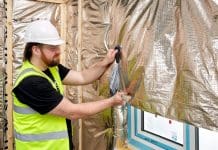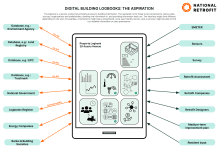In this article, Alexandra Gates, managing director of Simply Certification, takes a look at what measures the construction needs to take to meet carbon net zero targets
Let’s not beat around the bush; the UK is nowhere near hitting its carbon net zero targets.
Government rhetoric, reticence to act and miscommunication have resulted in ‘the UK failing to make progress on the net zero transition on nearly every measure’ according to the 2023 Progress Report issued by the Climate Change Committee.
24 million houses need to be retrofitted by 2050
This equates to 71,500 domestic retrofits delivered every month.
The number of homes receiving energy efficiency improvements under the government’s Energy Company Obligation scheme more than halved, from 383,700 in 2021 to 159,600 in 2022, despite the target now equating to between 1-2 million home upgrades per year. Something doesn’t add up.
If we are to tackle the retrofit targets in the UK, then the industry needs to create a consortium of forward-thinking businesses, ready to take on the challenges of carbon net zero within the built environment.
It is only by seeing beyond the immediate and the tactical that we will get anywhere near where we need to be.
Why is a business approach to carbon net zero needed?
If we do not hit the targets set, irreparable damage may be done to our environment- which will cost us more than money.
Let’s first tackle the elephant in the room- the cost-of-living crisis.
If we are to tackle this, then investing in future technology and retrofit may seem counter-intuitive; but this is a long-game. Healthier and more energy-efficient homes will negate much of the cost of heating, ventilating and maintaining a home.
The issue then, is not one of the cost-of-living but the cost to improve living- and who is willing to pay for it.
In my mind- and as is often the case, the private sector needs to lead the charge. A robust understanding of the shortfalls and gaps in the market is needed. The retrofit targets aren’t being met on two fronts, one is economic, one is supply.
There is currently a shortfall of 150,000 retrofit professionals
It is estimated that there is currently a shortfall of 150,000 retrofit professionals, 3000 retrofit co-ordinators and only 5% of the plumbing and heating workforce trained on installing heat pumps.
‘Retrofit’ standards and registrations include MCS, PAS 2030, PAS 2035, PAS 2038 and TrustMark. These standards have been developed to ensure installation does what it should and helps to achieve energy efficiency targets, reduce energy bills, make buildings healthier and positively impact people’s personal budgets.
With the upcoming changes to Awaab’s Law later this year following his tragic death, there has never been a more important time to focus on healthier homes. But there is a huge shortfall of energy efficient installers – and it’s only through partnerships that that we will convince companies to act in time.
The foundations have been laid for working partnerships already – to a high degree of success. Larger contractors are upgrading void stock to well above the government EPC rating of C and manufacturers are releasing products that will tackle the damp, mould and cost-of-living crisis in one go.
But to make this work, it requires an end-to-end training, certification, installation and re-training programme. This will ensure that future installs are compliant and installer businesses are training the next generation of fitters.
A Blueprint for success: From certification to a decarbonised nation
As an industry, we need to be lobbying the government to incentivise existing companies to upskill, encourage new entrants to the burgeoning market and open up supply chain opportunities for smaller contractors with sustainability at their heart.
We need to be educating these companies on a regular basis – through a national network of events designed to demystify the compliance and certification process and collaborating with larger construction players to open up opportunities for new build and retrofit installations.
Improving clarity around certification
Compliance and certification companies are working to demystify the certification process. At the coal face we see reticence to go through certification as it is deemed too hard or too compliance heavy.
A lot of our enquiries are from companies that are not yet ready for certification, so we have worked hard to build up a network of reliable partners to help de-complicate the process.
Usually, compliance issues arise with insurance backed guarantees, training and qualifications, process or procedures – issues that can be solved with a straight-forward, step-by-step approach.
Once we have all the factors in place, the timeline to gain certification can be reduced from six months to six weeks – creating flow at the top of the funnel. But as well as breaking down the barriers, we must be looking to build bridges. If we are to meet these numbers, we need to develop watertight supply chains from the certification company to the end user.
Manufacturers, housing providers, and contractors need to amplify communication with the public
Not enough has been done at the top to communicate the opportunity, and the urgency of it, for the retrofit market, so compliance auditors, certification companies, manufacturers, contractors and housing providers need to be working together to amplify this through engagement and education.
Great examples of this include ‘Meet the Buyer’ events and joint awareness sessions with primary contractors and their supply chains, which have been extremely effective in increasing the number of contractors gaining their certification.
Larger contractors need to partner with smaller contractors
The ‘Eco’ industry was driven largely by installers that specialised in energy-efficiency funded work direct with the homeowner. Unfortunately, a few bad apples caused it to be dogged with a poor reputation, which has put off a good proportion of contractors from entering the market.
However, we are now seeing a shift towards new entrants, driven by large primary contractors who are growing their supply chains to include smaller companies.
Having the support of these larger contractors is creating trust and confidence for smaller players, encouraging them to take that leap of faith into retrofit, which is a fantastic stepping – stone into the world of ECO-funded works.
By partnering with agile smaller contractors, large players can deploy the qualified teams necessary to hit lofty targets.
What’s next on the road to carbon net zero?
The supply chain needs many more people and organisations to get involved in Energy Efficiency Retrofit if the UK is to meet its carbon net zero targets.
When contractors have an order book full for a year of their ‘bread and butter’ work, the perceived hassle and cost of gaining the relevant certification and registrations to operate under energy-efficiency funding schemes starts to look less attractive. But to future-proof their business, there is a blueprint and support network available, meaning there are no real barriers to entry.
It’s vital that the larger contractors, housing professionals and mortgage providers help drive the message that the UK needs more contractors to upskill into this market, whilst encouraging future generations. The opportunities are fantastic and future-forward.
Alexandra Gates

MD
Simply Certification

















